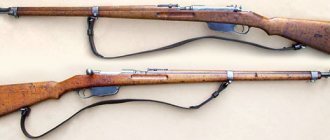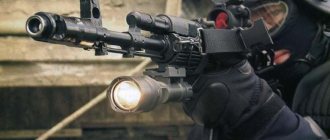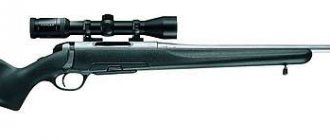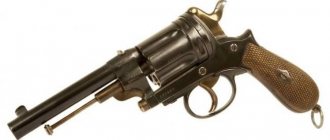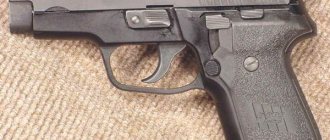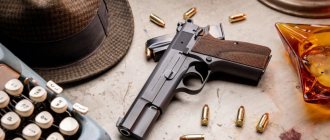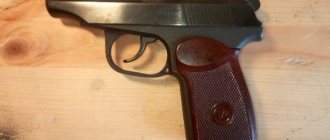Home | Weapons | Traumatic self-defense weapon - ooop | Pistol Steyr M-A1
The Steyr M-A1 pistol chambered for the 10×28 traumatic action cartridge is certified as a firearm of limited destruction
Pistol Steyr M-A1
The Steyr M-A1 10x28 caliber pistol is a limited-kill firearm fired with 10x28 traumatic cartridges loaded with rubber balls. Self-loading pistols have been produced by the Austrian arms company Steyr Mannlicher since 1912 and have an excellent reputation throughout the world thanks to such qualities as excellent ergonomics, a high degree of safety in handling, consistently high quality, reliable operation and excellent shooting accuracy. The Steyr M-A1 pistol is manufactured by Steyr in Austria, and the official importer in Russia is.
Steyr Manlicher pistols were developed by the talented designer and shooter Wilhelm Bubits. The automatic operation of the Steyr M-A1 pistol works according to the scheme of using recoil with a short barrel stroke. The barrel is locked by a massive protrusion of the rear part of the barrel, which enters the window of the shutter-casing for extracting spent cartridges. The barrel is unlocked by lowering it through the interaction of a figured cutout in the boss under the barrel with the protrusion of the frame. The rubber-fired Steyr M-A1 10×28 caliber, which belongs to the OOOP, differs from its combat prototype Steyr M-A1 caliber 9mm Parabellum by the presence of a pin in the barrel bore similar to the Grand Power T12 pistol. In addition, the barrel of the rubber-fired Steyr M-A1 is made non-removable to comply with Russian forensic requirements.
To ensure reliable operation of the Steyr M-A1 automatic with traumatic cartridges, the manufacturer made the necessary changes to the design, as a result of which the stroke length of the bolt-casing was reduced compared to the prototype 9mm Parabellum caliber. The pistol frame consists of two main parts - a steel frame and a polymer shell with a handle. The steel frame is one of the main parts of the Steyr M-A1 pistol, since it has guides for moving and attaching the bolt-casing, a reflector, and also parts of the trigger mechanism, safety and bolt stop lever are attached to it. The plastic handle can be easily and quickly replaced. In the front part of the polymer shell there are Picatinny rails, which allow you to attach various tactical flashlights and laser designators to the weapon, or sighting units combining both of these systems.
The trigger mechanism of the Steyr M-A1 pistol is striker-type, with preliminary, partial cocking of the firing pin when the bolt-casing moves back and additional cocking when the trigger is pressed. The trigger mechanism of the pistol Steyr M-A1 cal. 10x28 is characterized by the absence of failure, as well as the short length and smooth travel of the trigger with each shot, which ensures high accuracy, both at low and high rates of fire. The trigger of the Steyr M-A1 pistol is equipped with a safety lever that blocks its backward movement and is released only when the shooter consciously presses it. To protect against an accidental shot when dropped, the Steyr M-A1 is equipped with an automatic firing pin safety and an automatic trigger safety. To protect against unauthorized access to weapons by third parties, the Steyr M-A1 pistol is equipped with a built-in lock with which you can lock the trigger and the bolt-casing, which is done with a separate key included in the kit.
On the right side of the handle Steyr M-A1 cal. 10x28 barrel locking lever is placed. The magazine release button and bolt stop lever of the Steyr M-A1 pistol are located on the left side of the frame. The magazine release and slide stop cannot be mounted on the right side, which is a disadvantage for left-handed owners. The pistol handle is equipped with a protrusion for the middle finger, which is universal in ease of use by people with different palm sizes. The angle of the handle, which is 110 degrees, makes holding the Steyr M-A1 pistol comfortable and stable, and due to the minimum distance between its butt plate and the central axis of the barrel, the weapon has a small recoil shoulder and toss when firing, which facilitates quick aiming at the target after each shot.
New modified pistol grip Steyr M-A1 cal. The 10x28 has excellent ergonomics, making the pistol stable when holding and shooting. The handle surface design provides a good grip. The Steyr M-A1 pistol is fed with cartridges from detachable box magazines with a capacity of 10 rounds, or a larger capacity of 15 or 17 rounds. The pistol comes with two magazines. Steyr Manlicher pistols of the “M” series are equipped with special sighting devices that have never been used before. The front sight is made in the shape of a triangle, and the rear sight has a trapezoidal shape and a cutout. According to reviews from owners of the Steyr M-A1 pistol, with a front sight and rear sight of this configuration, aiming is faster than with conventional rectangular ones. Both the front and rear sights are made of steel.
Quality pistol Steyr M-A1 cal. 10x28 is beyond praise, which is true for all weapon parts, including surface treatment. Partial disassembly of the Steyr M-A1 pistol is very simple and quick. To disassemble, you need to remove the magazine, make sure that there is no cartridge in the chamber, move the firing pin to the front position by pressing the trigger, press the lock on the right side of the frame, turn the flag, and remove the bolt-casing from the frame guides forward. The guide sleeve with the return spring is removed from the shutter-casing. The Steyr M-A1 pistol is assembled in the reverse order. Currently, the Steyr M-A1 pistol cal. 10x28 has a certificate of conformity for firearms of limited destruction, 10x28 cartridges for the Steyr M-A1 pistol also have a corresponding certificate.
Reviews from owners of the Steyr M-A1 pistol
“It does not require any fine-tuning, it shoots out of the box clearly, on target, almost identically with any batch of AKBS cartridges. The solution to lowering the STP is simple, the triangle is above the whole. It feels like comparing domestic rubber arrows on sale (without taking into account historical and collectible value): like a good foreign car in relation to the domestic automobile industry. Big disadvantage: you can’t get the barrel out for cleaning, you don’t want to touch the pin on the frame, but it breaks the bottom of the barrel when shooting. All, of course, personal opinion. Regards, Oleg".
(c) nafnaf3422.guns.ru
“The first batch of Steyrs (LWW - released in February 2011), which were sold by AKBS in March-April 2011, did not want to work out of the box at all: the automatic pistol did not work, misfires occurred. The reason, as it turned out, was the shape of the reflector and the shape of the chamber. As a result, the shape of the reflector was changed, the ejector tooth was changed (they began to set it from 40SW, and in the LWW batch it started from 9x19). They couldn’t change the shape of the chamber, so already in March AKBS changed the shape of the produced 10x28 cartridge with a rubber bullet, reducing the rolling of its head part (the cartridge stopped falling into the chamber and misfires due to undershooting disappeared).
Today, the moment of reaching a certain firing rate hangs over all owners of traumatic Steyrs with a “sword of Damocles” (I, as the owner of the LWW and SWW series Steyrs, from my personal experience, determined this moment at 500-600 shots with AKBS 10x28 cartridges with a rubber bullet). Upon reaching the specified shot with the pin/obstacle, changes occur in the barrel - some are successful, some are not so successful. After the onset of such changes, the owner of the traumatic Steyr is left with himself. Since today it is impossible to replace a damaged pistol with a new one under warranty - there is nothing to change it for...
That is, in fact, the traumatic Steyr is brought down by PINS (pin/obstacle in the barrel, barrel travel limiting pin in the frame, barrel locking pin in the bolt), which are not in the prototype. I think that if there were no pins in the barrel, slide and frame, there would be no problems with the pistol...” (c) Sergey
Steyr M-A1
Pistol Steyr M40-A1
Steyr M-A1 is an Austrian self-loading standard double-action pistol produced by Steyr-Manlicher GmbH since 2004.
| Ammo | 9x19 mm Parabellum | .40S&W | .357 SIG |
Tactical and technical characteristics of the pistol Steyr M9-A1 (Steyr M9-A1)
Pistol Steyr M9-A1
• Length – 175 mm • Thickness – 30.5 mm • Height – 122 mm • Weight – 771 g. • Barrel - 102 mm • Magazine - removable, box-type with a capacity of 17 rounds • Initial bullet speed - 390 m/s
Tactical and technical characteristics of the pistol Steyr M40-A1 (Steyr M40-A1)
Pistol Steyr M40-A1 with magazine
• Length – 175 mm • Thickness – 30.5 mm • Height – 136 mm • Weight – 771 g. • Barrel - 102 mm • Magazine - removable, box-type with a capacity of 12 rounds • Initial bullet speed - 285 m/s
Steyr M- pistol was created by gunsmith designer Wilhelm Bubits, creator of Glock pistols, based on the Steyr M pistol. In the process of modernizing the Steyr M pistol, the ergonomics were improved, the angle of the handle was changed, a universal “Picatinny rail” type guide was installed on the frame, and the barrel was replaced with a barrel with an anti-corrosion coating. This pistol was called Steyr M-A1.
the Steyr M-A1 pistol operates on a recoil system when fired with a short barrel stroke. The barrel bore is locked by skewing it in a vertical plane; using a massive protrusion in the upper breech of the barrel behind the extractor window in the bolt casing. This is according to Browning's principle. The barrel bore is unlocked when the breech is lowered, when the shaped protrusion in the lower part of the chamber interacts with the protrusion in the pistol frame. The barrel is made using the cold forging method with an anti-corrosion coating, has 6 right-hand ordinary rifling.
The trigger mechanism (trigger mechanism) of the Steyr M-A1 is striker-type, only double-action with a constantly half-cocked striker. The striker has an automatic lock, which can only be released in any case when the trigger is fully pressed. The trigger, in turn, is equipped with an automatic external locking device. When you press the trigger, you must first release the lock with your finger, and then squeeze it. The Steyr M-A1 pistol is also equipped with a special lock on the right side of the weapon, which locks using a special key included with the pistol, the trigger and the bolt housing. This lock makes it impossible to fire the pistol or disassemble it. For the US market, a manual mechanical safety is installed, to activate which you need to immediately press the buttons located above the trigger guard on both sides.
The frame of the Steyr M-A1 pistol is made of impact-resistant plastic with a metal frame to provide greater rigidity. Metal inserts are mounted in places where the shutter casing slides. The frame under the barrel is equipped with a universal “Picatinny rail” type guide for installing various additional accessories (tactical flashlight, laser designator, etc.). The shutter casing is also made of impact-resistant plastic. The handle of the Steyr M-A1 pistol is also made of plastic, has an ergonomic shape and an inclination angle of 110°. This is done in order to reduce the distance between the butt plate of the handle and the axis of the barrel, which reduces the jump of the weapon when fired.
Sights and pin indicator for the presence of a cartridge in the chamber
The sights of the Steyr M-A1 pistol consist of a metal triangular front sight and a metal trapezoidal rear sight. The front and rear sights have tritium inclusions, which emit a glow in low visibility conditions. Sighting devices are installed on the upper part of the bolt casing in transverse dovetail grooves.
On the back side of the bolt housing of the Steyr M-A1 pistol there is a pin indicator for the presence of a cartridge in the chamber, which can be easily felt with a finger.
The Steyr M-A1 pistol is fed with cartridges using a removable double-row box-type magazine with a narrowing at the top. The magazine feeder spring is made of very high quality steel and is not afraid of weakening during long-term storage in a compressed state. The feeding of cartridges from different manufacturers is very reliable, without jamming. The magazine release button is located on the left at the base of the trigger guard.
Advantages:
- High muzzle energy
- High strength of both the massive shutter-casing and the frame thanks to its steel frame
- Large magazine capacity
- Excellent ergonomics
- No protruding parts
- Easy to handle weapons due to the presence of only automatic fuses and no manually controlled ones
- High degree of safety due to the combination of two automatic fuses with an indicator of the presence of a cartridge in the chamber
- Excellent workmanship and surface treatment of all weapon parts, as well as the workmanship and reliability of original Shtaer magazines
- Excellent for sport shooting according to IPSC/IPDA rules
Pistol Mannlicher M1901/M1905
| Mannlicher M1901 |
Due to the need of the troops for personal weapons, the famous gunsmith Ferdinand Mannlicher began work on a pistol with a locked bolt in 1896, but he was not able to achieve satisfactory results until the early 1900s.
Mannlicher M1901
At the same time, he simultaneously improved his blowback pistol and ultimately received a weapon that many still consider to be a model of elegance. It is usually referred to as the "Model 1901" (Mannlicher M1901), but the earliest examples of this pistol were manufactured back in 1898, when the first patent was issued.
Unfortunately, the sample of this weapon chambered for 7.63 mm, preserved after tests that took place in Switzerland in 1898–1899, does not allow us to establish where and by whom it was manufactured. In addition, the cartridge used in the pistol was not the 7.63 mm Mauser cartridge, which was common at that time, which would have been too powerful for a blowback system. It was a special Mannlicher cartridge with a bullet weighing 85 grains.
| Mannlicher M1905 |
Production of the already improved Mannlicher M1901 pistol was established in Steyr (since it went bankrupt and was bought).
Position of parts of the Mannlicher pistol mod.
1905 before firing: 1 - bolt; 2 - trunk; 3 — return spring; 4 - frame; 5 — feeder spring; 6 — feeder; 7 - trigger; 8 - striker The Mannlicher pistol of the 1901 model was willingly purchased privately by many officers of the Austro-Hungarian army, although after the tests of 1904–1905. an official decision was made not to adopt this weapon.
However, this pistol gained particular popularity in Latin America, where it could be found many years after it had practically disappeared in Europe. In 1905, it was adopted by the Argentine army under the name “Model 1905” (Mannlicher M1905).
The Mannlicher pistol became one of the first open-barrel automatic pistols in its time.
The automatic operation of the Mannlicher M1901 / M1905 pistol operates on the principle of blowback recoil with deceleration.
A special lever connected to the mainspring acts as a retarder. The pressure of the mainspring on the lever helps slow down the movement of the bolt and absorb part of the recoil energy. Mainspring (top) and trigger (bottom) of the Mannlicher pistol mod.
1905. The barrel is motionless. It is screwed into the bushing of the pistol frame and forms a single unit with it. The bolt casing consists of a short bolt with an ejector with a spring tail and a firing pin with a spring installed in it, and two long strips extending from it (one on each side), which are connected by a front bridge under the barrel. The return spring is located in the channel under the breech of the barrel and is put on the front jumper of the bolt casing, so that when the latter moves backward, the spring is compressed.
The pistol has a large open trigger and simple trigger pulls, covered on the left side with a removable plate. The driving mainspring is placed on the right side of the frame, so that its lower arm presses on the trigger, and the upper arm presses on a small lever, the end of which interacts with the cutout in the lower part of the bolt casing. The plate covering the spring is connected to the plate of the trigger mechanism using a forward-curved rod. Under the return spring, this rod is locked with a spring-loaded latch.
After the shot, the bolt-casing, overcoming the resistance of the return spring, moves back until the lever in the groove on the right side is pulled down. This is also prevented by the mainspring, the action of which the bolt-casing has to overcome additionally, since, moving backward, it cocks the hammer, which, through the mainspring, exerts even more pressure on the retarder lever. Thus, due to the increase in friction force, the movement of the bolt-casing slows down and part of the recoil energy is absorbed.
Having reached the rearmost point, the bolt-casing begins to move in the opposite direction and sends another cartridge into the chamber. The permanent magazine is located in the pistol grip.
| Mannlicher M1905 |
Mannlicher M1901 / M1905 partial disassembly
Early examples of the pistol used a large lever as a safety lever, locking the trigger from the inside, which was operated by the thumb. Later samples had a simpler safety device, which was located on the back of the bolt casing and was simply lowered onto the trigger.
The trigger mechanism is hammer type with an open trigger, single action.
The weapon is fed with ammunition from a permanent box-type magazine with a single-row arrangement of cartridges with a capacity of 8 or 10 rounds, located in the pistol grip. The pistol is loaded from the top of the weapon from a flat clip, through the bolt-casing, which is in the open position. The cartridges are held in the magazine by a special latch. When you press a special latch, all the cartridges in the magazine are moved upward and can also be removed from the pistol through the open bolt-casing.
The pistol has a permanent sight, open type, consisting of a front sight and rear sight. The first pistols had a front sight with a rounded leading edge; in later samples it was vertical. The sight slot was originally a groove machined into the post above the breech of the barrel, which was forged along with the frame and covered by the front lugs of the bolt in the locked position. The later sight of the Model 1905 pistol looked like a cut in the rear end of the bolt housing.
| Mannlicher M1905 with holster and ammunition |
| Caliber, mm | 7.63; 7.65 |
| Length, mm | 211 (with 130 mm barrel) |
| Barrel length, mm | 130 (140; 160) |
| Weight, kg - without cartridges - with cartridges | 880 920 |
| Store, count. cartridges | 8; 10 |
| Initial bullet speed, m/s | 300 |
Mannlicher M1901 / M1905 pistols were produced with different barrel lengths (from 130 to 160 mm), grip shapes and magazine capacities. There appears to have been no general standardization of such options. Typically the barrel length was 140 mm.
The use of barrels of different lengths, as well as magazines with 8 or 10 rounds, made it possible to create several variants of these pistols. They were easy to use, “handy”, had good accuracy and reliable operation of the mechanisms, but were low-tech - the manufacture of many parts required the use of numerous labor-intensive operations.
Mannlicher M1905 when loading, adopted for service in Argentina
The pistols produced in 1898 did not have any inscriptions, with the exception of the Mannlicher trademark on the handle - the letter M enclosed in a circle and topped with a crown, or a cross. However, already on samples of 1900–1901. the inscription PATENT MANNLICHER appears on the left side of the shutter casing. Subsequently, the mark WAFFENFABRIK STEYR was applied to the cover of the trigger mechanism on the left side. All pistols of the 1905 model, with the exception of those produced under contract for Argentina, have the inscription Md.l905 / WAFFENFABRIK / STEYR in three lines on the left side of the frame, and SYSTEM MANNLICHER on the right side of the frame. On pistols intended for delivery to Argentina, the same inscription was placed in its entirety - in five lines on the left side, and the right side was left free for the emblem of the national armed forces of Argentina to be applied to it. The serial numbering of pistols produced in the 1900s was carried out anew. So, for example, for the 1901 pistols produced in Steyr, the numbering again began with one and continued sequentially until the end of production of the Mannlicher M1905 sample around 1910. In total, about 10,000 of these pistols were produced.
| Mannlicher M1905, adopted by Argentina |
Technical characteristics of the Steyer Mannlicher pistol
- Caliber: 10×28
- Weapon length: 183 mm
- Barrel length: 102 mm
- Weapon height: 130 mm
- Weapon width: 30 mm
- Weight without cartridges: 766 g.
- Magazine capacity: 10 (15 / 17) rounds
Traumatic self-defense weapon - ooop
- Firearms of limited destruction
- Pistol Leader-M
- TT-T pistol
- Pistol Groza-03 / Groza-031 EVO
- Taurus LOM-13
- Revolver Agent TKB-0216T
- Pistol Steel/Steel-2
- Pistol Leader
- Pistol MP-78-9TM
- Pistol Izh-78-9T
- Barrelless pistol Osa Compact
- Groza series revolvers
- APS-M pistol
- Pistol PST Corporal
- Barrelless pistol Osa PB-4-2
- Tanfoglio INNA pistol
- Pistol MP-81 / MP-82
- Pistol Groza-05 / Groza-051 EVO
- Pistol WASP R
- Pistol Esaul / Esaul-3
- Pistol Makarych Izh-79-9T
- Pistol Fort-17T / Fort-17P
- How to obtain a license for an LLC
- Pistol Groza-02 / Groza-021 EVO
- Revolver Taurus 9mm PA
- Pistol Jorge-3
- Pistol Streamer 1014
- Jorge's gun
- Pistol MP-79-9TM
- Pistol MP-353
- General questions about choosing a traumatic weapon
- Pistol Groza-01
- Barrelless pistol Shaman
- Pistol MP-355 Stechkin
- Pistol Fort-12T / Fort-12P
- Cartridges for traumatic pistols
- Pistol Jorge-1
- Pistol Makarych Izh-79-9T-10
- Pistol Groza-04 / Groza-041 EVO
- Pistol PM-T
- Pistol Grand Power T 910
- Barrelless pistol Osa PB-4
- Pistol Steyr M-A1
- Pistol Phantom-T
- Pistol Stalker
- Revolver Nagan-RF
- Revolver Naganych R-1
- Options for purchasing and selling LLCs according to the law
- Barrelless pistol Guard MP-461
- Grand Power T11
- Revolver Nagan-M
- Grand Power T12
- Pistol MP-80-13T
- Pistol Scorpion Sa vz.61 Rubber
- Pistol P226T TK-P
- Pistol Grand Power T10
- Barrelless pistol Egida PB-2
- Pistol CZ 83 Rubber
- Pistol MP-341 Howdah
- Barrelless pistol Cordon
- T4 Terminator pistol
- TTK pistol
- Revolver Ratnik 410×45TK
- Shark pistol

